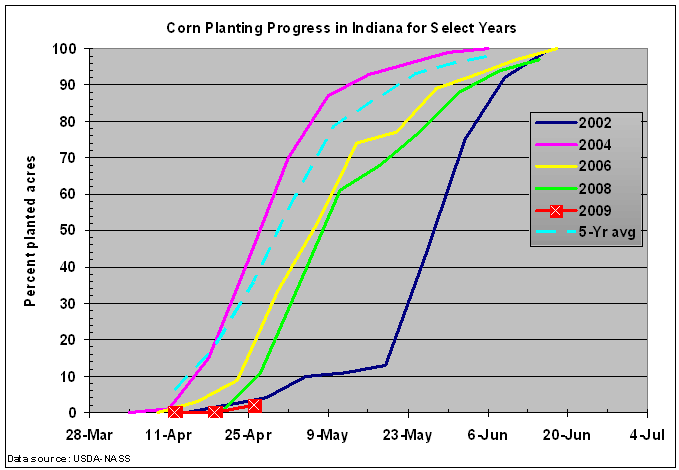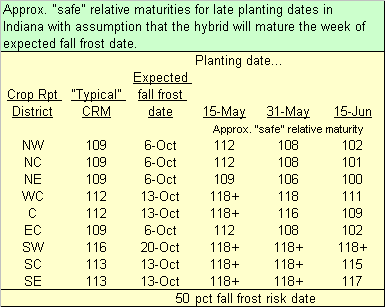Published 28 Apr 2009
URL: http://www.kingcorn.org/news/articles.09/DelayedPlt_Hybrids-0428.html
Late Planting & Relative Hybrid Maturity Decisions
R.L. (Bob) Nielsen
Agronomy Dept., Purdue Univ.
West Lafayette, IN 47907-2054
Email address: rnielsen
at purdue.edu
![]() ndiana's corn planting progress is barely on the "radar screen" as of April 26 (USDA-NASS, 27 Apr 2009) as a result of frequent rains that have prevented soils from drying enough to allow for spring tillage and planting. The pace of planting, at the moment, is slower than the extremely slow planting season of 2002 (Fig. 1).
ndiana's corn planting progress is barely on the "radar screen" as of April 26 (USDA-NASS, 27 Apr 2009) as a result of frequent rains that have prevented soils from drying enough to allow for spring tillage and planting. The pace of planting, at the moment, is slower than the extremely slow planting season of 2002 (Fig. 1).
Some of the locals who frequent the Chat'n Chew Café are beginning to question when they should consider replacing their full-season corn hybrids with shorter-season versions. They worry that, after some point on the calendar, full-season hybrids may not mature safely before the first killing fall frost. After all, they argue, hybrid maturity ratings are closely associated with the accumulation of Growing Degree Days (GDDs) after planting (Fig. 2) and there are only so many GDDs available in a given growing season prior to killing fall frosts.
Fortunately, we know from previous research (Nielsen et al., 2002) that corn hybrids reduce their GDD needs as planting is delayed. This means that late-planted hybrids mature in fewer than expected GDDs from planting. The number of GDDs required from planting to physiological maturity in corn decreases nearly 7 GDDs per day of delayed planting after May 1. For example, a hybrid planted June 1 will mature approximately 210 GDDs sooner than it would if planted May 1 (30 days times 7 GDDs per day of delayed planting).
The bottom line from this research is that a given hybrid maturity can be planted later than we once thought possible and still mature safely before a killing fall frost. Nevertheless, at some point on the calendar, growers eventually need to consider switching to earlier maturity hybrids to minimize the risk of frost damage in the fall.
The tables that follow summarize the delayed planting effect on hybrid GDD requirements and present the results in terms of "safe" hybrid maturities for a range of delayed planting dates (see Nielsen & Thomison, 2003, for more information). Both tables assume "normal" GDD accumulations for the remainder of the growing season and a fall frost date that is based on a 50% risk of frost occurring by a given date for individual crop reporting districts around the state (Indiana State Climate Office, http://iclimate.org).
Table 1 targets physiological maturity occurring the same week that a killing frost is expected to occur. Table 2 targets physiological maturity occurring the week before a killing frost is expected to occur. The "safe" hybrid maturities listed in Table 2, therefore, are a bit less risky relative to maturation and killing fall frosts.
The hybrid maturities listed in the tables are described in terms of "CRM" or comparative relative maturity ratings as defined by Pioneer Hi-Bred (2008). Pioneer publishes relative maturity data for hybrids in terms of both CRM ratings and GDDs from planting to physiological maturity. Such data can be used to define the relationship between CRM ratings and GDD requirements (Fig. 2). That relationship coupled with our previous research on the effects of delayed planting on GDD requirements allow me to estimate "safe" hybrid maturities for a range of planting dates (Tables 1 & 2).
DISCLAIMER: I am NOT suggesting that Pioneer hybrid maturity definitions are the industry standard. Nor am I promoting Pioneer hybrids. I work with Pioneer's hybrid maturity data because a) many farmers and consultants can relate to Pioneer hybrid maturity ratings and b) I cannot easily find similar on-line datasets for the complete hybrid lineup for any other major seed corn supplier.
BOTTOM LINE: The good news is that growers in the central and westcentral Indiana plus the entire southern third of Indiana could continue to plant full-season hybrid maturities through at least the end of May. Growers in the northern third of the state and eastcentral Indiana who routinely "push the limits" of adapted hybrid maturity may want to consider switching to something less than 110 day hybrids before the end of May. In addition to managing the risk of not maturing prior to a killing fall frost, the eventual agronomic decision to switch to earlier maturity hybrids with delayed planting should result in drier grain at harvest (approximately one-half percentage point of grain moisture difference per "day" difference in hybrid relative maturity) and thus lower grain drying costs and less risk of low test weight grain.
Related References
National Weather Service. 2008. Precipitation Analysis. [On-line]. Available at http://www.srh.noaa.gov/rfcshare/precip_analysis_new.php. [URL accessed 5/11/08].
Nielsen, R.L. (Bob). 2008. Heat Unit Concepts Related to Corn Development. Corny News Network, Purdue Univ. [On-line]. Available at http://www.kingcorn.org/news/timeless/HeatUnits.html. [URL accessed 4/28/09].
Nielsen, R.L. (Bob). 2009. Corn Planting Date is Important, But..... Corny News Network, Purdue Univ. [On-line]. Available at http://www.kingcorn.org/news/timeless/PltDateCornYld.html. [URL accessed 4/28/09].
Nielsen, R.L. (Bob) and Peter Thomison. 2003. Delayed Planting & Hybrid Maturity Decisions. Purdue Univ. Cooperative Extension Publication AY-312-W. [On-line]. Available at http://www.agry.purdue.edu/ext/pubs/AY-312-W.pdf [URL accessed 4/28/09].
Nielsen, Robert L., Peter R. Thomison, Gregory A. Brown, Anthony L. Halter, Jason Wells, and Kirby L. Wuethrich. 2002. Delayed Planting Effects on Flowering and Grain Maturation of Dent Corn. Agron. J. 94:549-558.
Pioneer Hi-Bred. 2008. Pioneer® Brand Products. [On-line]. Available at https://www.pioneer.com/growingpoint/product_info/catalog/PrdSelection.jsp [URL accessed 4/28/09] [NOTE: The Pioneer GrowingPoint Web site requires a login; either as a current Pioneer customer or as a guest. After you've completed the Web site registration process you will be routed to the "Search Products & Traits" Web page. From here, select "Corn grain" from the "Product Line" dropdown menu and click "Enter".]
USDA-NASS. 2009. Indiana Crop & Weather Report (27 May 2009). Indiana office of USDA's National Ag. Statistics Service. [On-line]. Available at http://www.nass.usda.gov/Statistics_by_State/Indiana/Publications/Crop_Progress_&_Condition/2009/wc042609.pdf [URL accessed 4/27/09].

Fig. 1 Corn planting progress in Indiana for 2002 (slowest pace in recent history), 2004 (fastest pace in recent history),
2006 and
2008 (relatively slow planting progress years), and to date (26 Apr) for 2009.
[Source: USDA-NASS]

Fig. 2. Relationship between hybrid relative maturity (CRM) ratings and heat
unit (GDU) accumulation from planting to
physiological maturity.
[Source: Pioneer Hi-Bred, 2008]
Table 1. Approximate “safe” relative
hybrid maturities for late planting
dates in Indiana with the assumption that the hybrid will mature the
week of the expected first fall frost date. The expected fall frost date
is that based on a 50% risk of frost occurrence. The acronym “CRM”
refers to Comparative Relative Maturity as defined by Pioneer Hi-Bred.

Table 2. Approximate “safe” relative hybrid
maturities for late planting
dates in Indiana with the assumption that the hybrid will mature one
week before the expected first fall frost date. The expected fall frost
date is that based on a 50% risk of frost occurrence. The acronym “CRM”
refers to Comparative Relative Maturity as defined by Pioneer Hi-Bred.


